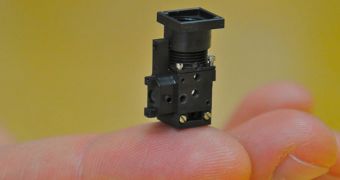Researchers at the Stanford University announce the development of a new type of portable microscope, which they say can be used either in the lab or on the field. The device fits neatly on a fingertip, and is constructed exclusively with existing technologies.
What this means is that it could theoretically be mass-produced at costs low enough to allow for widespread adoption around the world. Having access to such a technology could, for example, make it easier for doctors working in Africa to place diagnostics, or analyze water supplies.
According to the Stanford team, the device is equally well-suited for biological research and medical screenings. They add that additional uses are also possible, based on how much they will be able to improve the microscope in future researches.
The tiny instrument weighs less than 2 grams, yet it is perfectly capable of seeing fluorescent markers, of the type used to determine whether a certain protein is expressed in cells, or if a certain type of neuron is activated in a brain at a specific time.
Interestingly, there are absolutely no moving parts in this device, which means that operators will have no need to realign lenses like in larger microscopes. With the exception of the outer lens, the entire instrument is encapsulated, and therefore sealed against dust.
“You could put 10 of these in your pocket and take them out to the field to do ecological studies of soil or give them to aid workers to carry, so they could potentially do on-the-spot medical screening for diseases such as tuberculosis,” researcher Mark Schnitzer explains.
“This opens up possibilities for using microscopes where you just wouldn't dream of taking them today,” adds the team leader, who holds an appointment as an associate professor of biology and of applied physics at Stanford.
What's more, the efficiency of the new machines is comparable to that of their larger, bulkier counterparts. “Usually when people miniaturize things, the performance is not as good as the conventional-szed device, because you've constrained everything so much,” Abbas El Gamal explains.
The expert, a professor of electrical engineering at Stanford, is the co-author of a new paper describing the instrument, which was published online this week in the top journal Nature Methods. Mark Schnitzer is the other co-author.
“This microscope is going to be important not only for improving our basic understanding of how the neural system works, but also for looking at how some of those forms of activity may go awry in some brain diseases,” the latter concludes.

 14 DAY TRIAL //
14 DAY TRIAL //